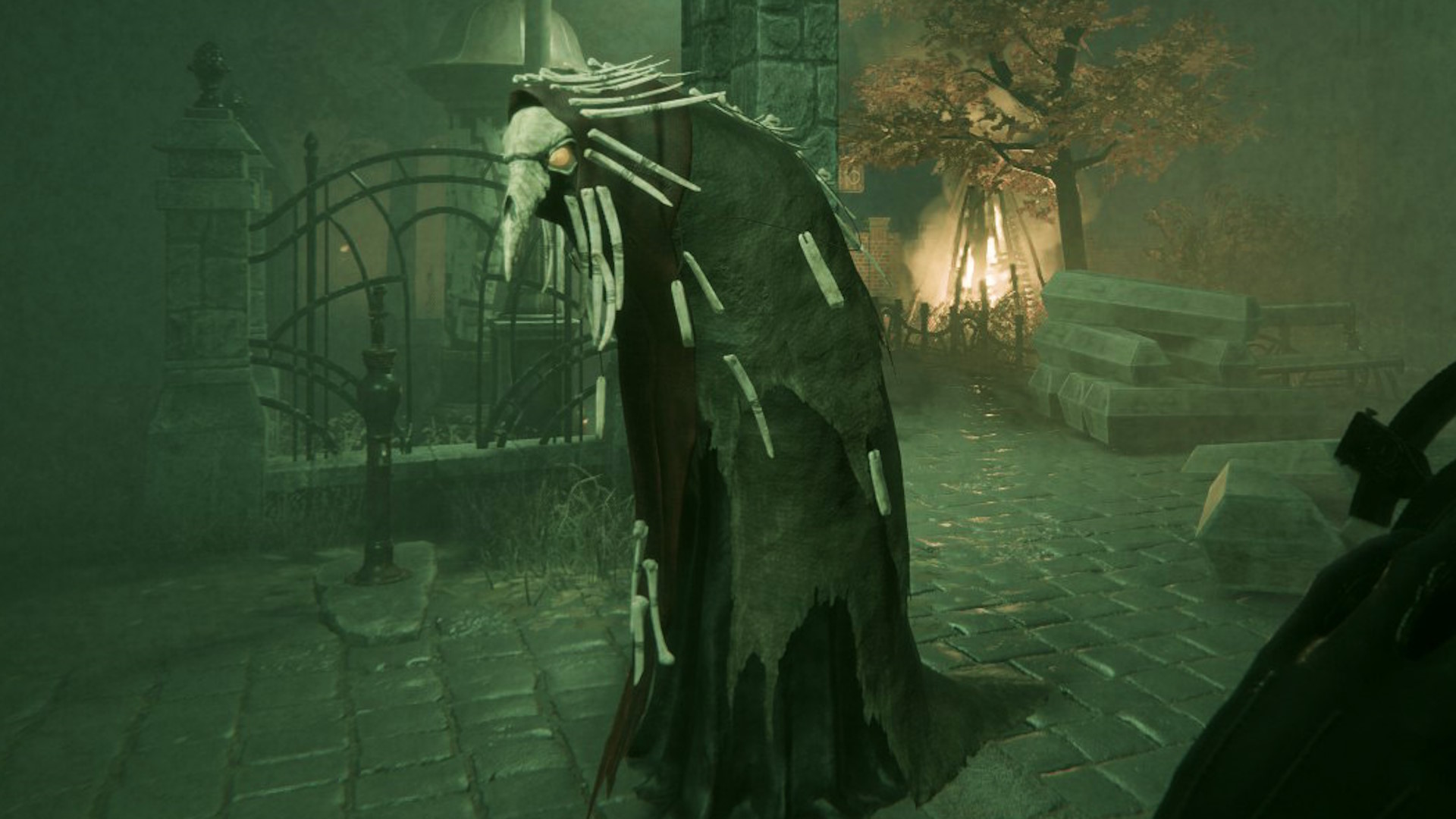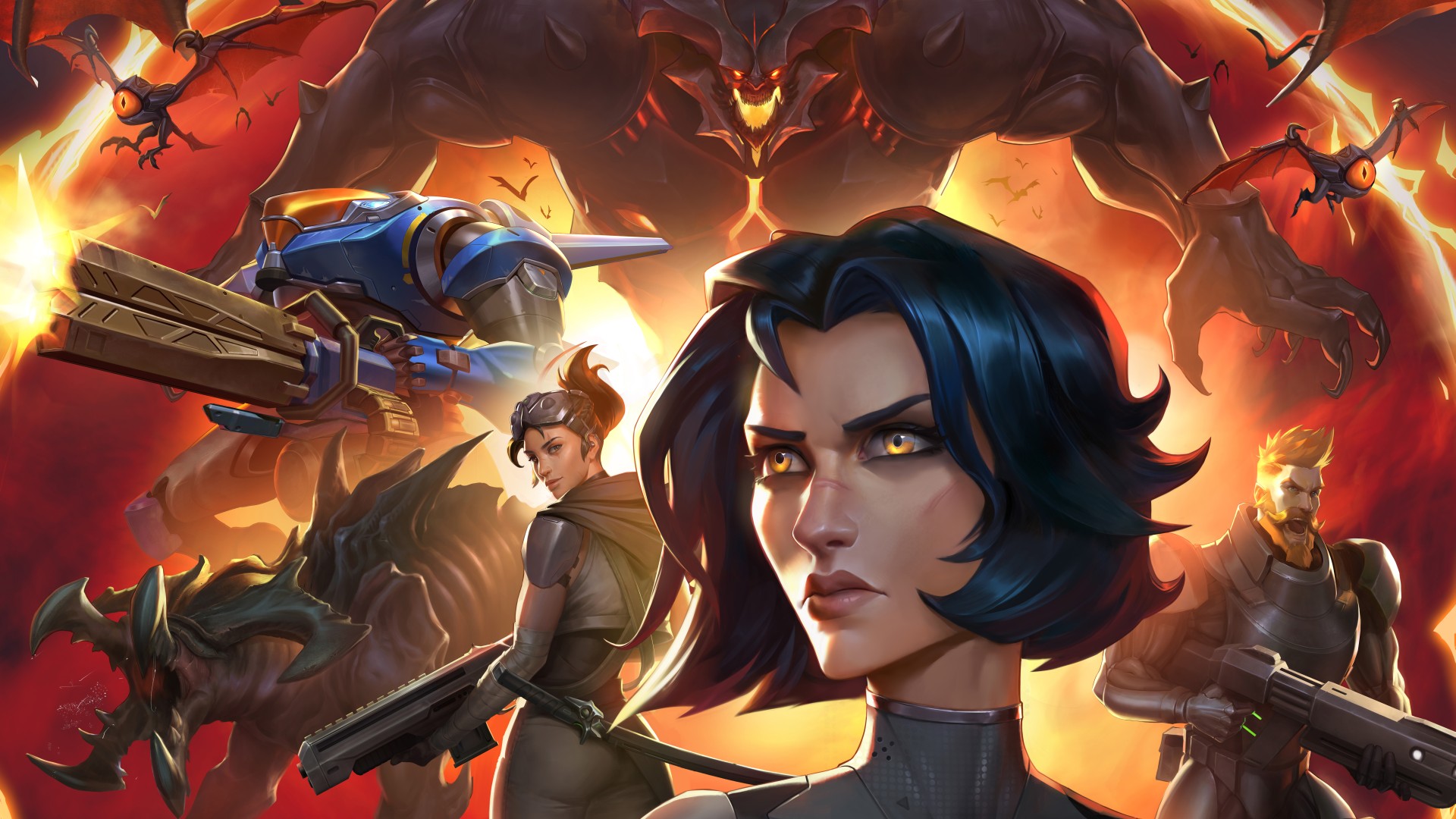
For a game with “Dino Forecasts” that warn the populace of thousands of dinosaurs about to rain out of portals in the sky, what’s surprising about Exoprimal is that it’s somehow even stranger than that premise would suggest. It’s a hero shooter that pits two teams of five against each other in dino-hunting war games, where they compete indirectly – but also occasionally directly – in separate parallel universes to see who can complete a grab bag of objectives faster. And sometimes they cooperate! It takes a lot of familiar elements from team-based multiplayer games like Overwatch and Team Fortress 2, and combines them with wave-based survival to create an experience that feels like its own thing, and a lot of fun if you’re able to find a well-balanced squad.
If it wasn’t already abundantly clear, Exoprimal multiplayer-only, but boldly, it’s a multiplayer-only game with the story and progression of a single-player game. The general set up of it all is the exact kind of silly sci-fi you’d expect: you and your squadmates are all trapped on a mysterious island where a catastrophe leaked dinosaurs into a near-future world. While your three squadmates collect data and try to figure out what the heck happened, you are whisked away by a malevolent AI called Leviathan to endlessly compete in a Dinosaur vs Exosuit themed war game, all for the sake of gathering combat data. It’s pretty clear this is where ChatGPT is headed, folks.
And it’s these war games that make up Exoprimal’s PvEvP (player-vs-environment-vs-player) multiplayer gameplay. You and another team rush to complete a series of fun, but initially limited objectives that range from simply killing X number of dinos, to capturing control points, to defeating an extra-beefy dino that tries to run away from you, forcing you to carve a way through hordes of velociraptors as you try to hunt it down. Much like in Capcom’s own Dead Rising, there’s a certain unique charm when it comes to decimating literally hundreds and sometimes even thousands of dinos in just one objective. The team that gets through their objectives the fastest gets a head start in the final round, which will either just be more PvE-style objectives, or will converge the two universes into one and have the teams directly competing to push their payload to the goal in a mode straight out of Overwatch.
There’s a certain unique charm when it comes to decimating literally thousands of dinos.
I really like this twist where the majority of each match of Exoprimal is an indirect race against the other team rather than slugging it out the whole time. Instead of focusing on hyper-precise accuracy, twitch reflexes, and map knowledge, you get to kick back and concentrate on efficiency for a bit. Things like making sure you’re staying on top of your cooldowns, using your special techniques so that they deal the most damage to the biggest number of enemies, and supporting your teammates so that they’re able to do their jobs as well scratch a uniquely satisfying itch in the usually directly confrontational space. It also makes the final round feel extra special, especially when it’s a PvP match – where the final team is essentially like the final boss. Here you have a totally different set of considerations to balance, like whether to stick with your team to try and push the payload faster or to break away and attempt to harass the other team to slow their progress down.
At certain points throughout the match, Leviathan will also allocate a ‘dominator’ to one of the teams, giving one player the ability to transform into a giant carnotaurus or triceratops and wreak havoc on the opposing team for a limited period of time. Does that make any sense? No, not really! Does it add even more layers of strategy to the match? You bet it does! Does your team use the dominator immediately and try to build a lead or make up ground? Or do you risk saving it for when you’re closer to the end and your opponents’ ultimate abilities are more likely going to be on cooldown, letting you run amok? Who on your team should be the one taking the dominator in the first place? Can your team make do without you while you’re harassing the other team as a dinosaur? All of these are the kinds of quick on-the-fly decisions that make Exoprimal’s multiplayer battles quickly expand to feel much deeper than they might seem after the first round or two.
Exo-Evoultion
If this was all Exoprimal was it would be little more than a fun but ultimately forgettable twist on the hero shooter genre that’s worth a weekend of play, but not much more. But after playing a set number of matches, something interesting happens: The story that’s been going on in the background suddenly takes the wheel and introduces new elements that reflect what’s happening in the world outside the war games, and those become permanent fixtures in every future match you play. As a result, hour 10 of Exoprimal is dramatically different than hours one through five, and hour 20 is dramatically different than hour 10. It’s full of surprises.
These curveballs range from new, more dangerous dinosaurs to fight, new objectives, new final rounds and, in the best moments, Leviathan will even straight-up cancel the standard 5v5 War Game and put both teams together to fight cooperatively in a 10-person boss fight or raid-like challenge with limited respawns. I don’t want to spoil their specifics, but these sequences are incredible surprises and are absolutely worth pushing through the repetitive early hours of fighting through the same handful of dinosaur types, objectives, and maps to get to them. The only negative thing I can say about them is that there’s no way to queue into the exact kind of match you want to play specifically – you just have to keep on grinding through matchmaking until Leviathan decides it’s time for another 10-person raid event. Though in a way, that makes it more special when you get to play one.
Hour 10 of Exoprimal is dramatically different than hour one, and hour 20 is dramatically different than hour 10.
Each match you complete unlocks nodes on the Analysis Map, an enormous chart that chronicles Exoprimal’s story. The idea is that the more matches you play, the more data your squad receives, and the more they’re able to learn about the various mysteries. These mysteries include: what happened on the island, why is Leviathan running these war games, why are there even dinosaurs raining from the sky in the first place, and the central plot point: how to escape the island. It took a while for Exoprimal’s story to sink its claws into me, and I don’t know if I would’ve seen it all the way through had it not been for a reviewer’s sense of diligence, but I’m glad that I did because eventually it does get fairly interesting once the mysteries of the island start to unravel. That said, don’t expect your party to be happy about you taking 20 minutes to view the next handful of cutscenes and video logs before queueing up for the next match.
Tyrannosaurus Rexosuits
This is a hero shooter, and that means it comes with a set of classes to choose from, and they’re divided into the usual three categories. There are no surprises here: Assault suits tend to focus on maximum damage, Supports are naturally the ones you’ll look to for heals and crowd control, and Tanks soak up damage and aggro. Within those classes, though, there’s a great variety of playstyles. My favorite exosuit ended up being Barrage, who focuses almost entirely on area-of-effect damage, which is great considering the fact that almost every match of Exoprimal has you dealing with hordes upon hordes of tightly grouped velociraptors. Barrage can equip a grenade launcher, remote mines, and stun grenades, and his ultimate turns him into a human missile that you can guide and manually explode for massive damage.
If Barrage sounds a lot like Junkrat from Overwatch, well, you’re right. There are a lot of parallels with Overwatch characters, some a little more brazen than others. And while I wish there was a little more originality in some of Exoprimal’s exosuit designs, they are generally different enough from their clear inspirations to never feel like straight up carbon copies.
The other roles are fun to play, too. Krieger’s bubble shield feels like a must in certain situations and you’ll always feel instrumental in your team’s success if you pick him; Roadblock is capable of holding the attention of big threats like the carnosaurus and triceratops to let the rest of your team focus on dealing damage; and Muramasa is a great blend of tank and assault classes by increasing his damage when he’s able to successfully block attacks. On the support side, Witch Doctor is a fun and easy-to-play Exosuit that just needs to focus on staying alive, dropping healing fields, and zapping dinos to paralyze them briefly; Skywave is capable of taking to the skies to get away from the action while using primary fire to heal allies; and Nimbus is another hybrid assault class that’s able to switch between healing and damage dealing bullets.
It’s a blast when you’ve got a communicative and well-balanced team, and frustrating when you don’t.
The teamwork-focused design of Exoprimal matches also leads to the very familiar issue of it being a blast when you’ve got a communicative and well-balanced team, and a very frustrating experience when you don’t. It’s an issue that’s exacerbated by the progression system, which encourages you to stick to a single exosuit by assigning each one its own level progression. The more you play with an exosuit, the quicker you’ll unlock the advanced modules that can dramatically affect its power, but this feels at odds with the hot-swappable nature of the actual mode. If I want to focus on unlocking modules for Zephyr, but my team already has three other assault characters, I’m then put in the uncomfortable position of either having to beg someone else to change, change myself and slow down my progression with Zephyr, or stubbornly refuse to budge and just play the match with a poor team composition. It’s not an ideal situation at all, and I wish there was a system that allowed me to continue progress on an exosuit’s level without being forced to play as that exosuit.
The good news is that the modules offer satisfying and very noticeable bonuses that reward skillful play and allow you to cater an exosuit to your playstyle. As an example, with Barrage I could either opt for a module that increases my blast radius and increases my ammo by four, or one that deals 15% more base damage when I land a direct hit with my grenade launcher. I took the second option, paired it with a module that let me reload by dodging, and now my Barrage feels like a damage machine when it comes to the large dinosaurs – as long as I stay on top of how much ammo I have left and make sure to dodge whenever I run out.
Microtransaction Reaction
From the get-go, we can establish that all of the items for sale in Capcom’s store are purely cosmetic, and there are no pay-to-win elements. There are a robust set of customization options for just about every layer of Exoprimal that range from skins, to emblems, to emotes, to stickers, and so on. Most of these are earnable with in-game currency, called Bikcoins, or by opening loot boxes called war chests, which are provided at semi-regular intervals when your character levels up. But naturally, most of the best ones are locked behind a premium battle pass that costs $10. Individual skins can also be purchased for $5 a pop. There’s a free track on the battle pass as well, but its offerings are extremely slim: a grand total of 11 unlockable items, with only one of those being a new skin.
Overall, in a world where it’s becoming more and more common for full-priced games to include seasonal battle passes, Exoprimal’s is far from the worst I’ve seen. Key to this is the fact that I still got a steady supply of cool earnable skins, emotes, and stickers outside of the battle pass just by playing multiplayer matches and earning War Chests, and you can also use your earnable Bikcoins to buy whatever non-battle pass skins you want without having to roll the dice on loot boxes. .






